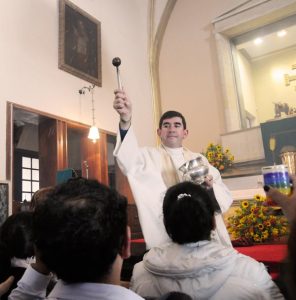by Roberta Staley

There’s nothing like a good tear-gassing to create camaraderie among people who, just moments before, were polite strangers. Mopping streaming eyes and hacking up caustic fumes is a shared experience that forges the unbreakable bonds of friendship.
We had been caught on the periphery of a peaceful student march that drew green-uniformed riot troops — lobbing tear gas and dispersal bombs — to the streets of downtown Bogotá in Colombia. Political scientist Dr. Juan Carlos Guerrero Bernal, my photographer Tallulah and I, after wiping our faces, did what any normal Colombian does after being gassed: go for dinner at a restaurant whose windows had just been violently shaken by rumbling black tanks.
Discussion of Colombia’s lawless history is inexhaustible, but eventually our conversation shifts to the frivolous. “You must go to this new club,” insists Guerrero. “It is the best in Bogotá.”
How could we say no?
The club, Andres Carne de Res, is located inside a glass office building in Bogotá. We trot up a double flight of stairs through enormous wooden doors into what looks like Cirque de Soleil. In the foyer, a four-metre-high, wrought iron leg plunges into an enormous red stiletto. Our diminutive hostess, in red evening gloves, ropes of pearls and an organza cape, floats rather than walks as she shows us to a small, round table. The crowd is gorgeous: women with silky waves of long black hair and men with heavy-lidded, sensuous dark eyes drink and dance together.
There are ship captains in blue uniforms wearing aviator glasses (how can they see in this dim light?). A waif in striped socks and Pippi Longstocking pigtails, prancing and pouty, flirts with customers. Sashes hang from the ceiling, which the captains leap on to from a ledge, swooping high overhead. There are musicians and aguardiente drinkers, who buy the anise-flavoured, colourless alcohol by the bottle and pass it around to strangers.
Then, someone else swoops in. A hot tamale of Colombian manhood salsas over to our table and beckons to the waitress to bring a round of tequila. We can barely hear each other above the thud of Afro-Colombian music, so we communicate by writing.
“Quiero,” he pens, meaning, “I want.”
Want what?
“Quiero hacerte el amore.” He turns the page and scribbles,“ Me gustaria besarte toda.”
My would-be Latin lover is becoming a bit too licentious for my prim Canadian tastes.
I am not surprised when our bill at evening’s end has a long tally of tequila shots drunk by my stymied suitor and his amigo, who have disappeared into the night.
Colombians take religion as seriously as they do partying. The next day, slightly worse for wear, my photographer and I joined the pilgrims heading to mass at Santuario de Monserrate cathedral, a white edifice towering more than 1,000 metres above Bogotá. Devoted worshippers scale the mountain’s steep, rough-hewn stone stairs. We opt for the cable car.
The cathedral is magnificent, with red, brown and black marble floors, vaulted pillars, confessional booths and statues of the Virgin Mary, saints and Christ on the cross, his face a mask of eternal suffering. The air is opaque with incense from silver vessels called thuribles that the priests swing back and forth.
The mass, one of five that day, finishes and worshippers line up at the altar to be blessed by the priest, who grasps a silver disc with holes that contain holy water. The priest flicks the holy liquid on to his flock. They hold up their small children and he blesses them, laying a gentle hand on their heads.
Then, the priest spies me, and all trace of beneficence evaporate. I freeze as he strides closer. The priest swings his holy water sprinkler at me, dousing my face and notepad.
A divine cleansing, I decide, that is sorely needed after the tear-gassing and drinking of the past 24 hours.
About the author:
Roberta Staley is an award-winning magazine editor and writer with experience reporting from the developing world and conflict and post-conflict zones, including Afghanistan, Haiti, Colombia, Cambodia and Soweto.
She is the editor of the national science magazine, the Canadian Chemical News, and teaches magazine writing in Douglas College’s Communications Department. Staley is also a graduate student at Simon Fraser University.
http://journeystotheedge.com – Blog
http://robertastaley.ca – Website
Photo: Tallulah Photography